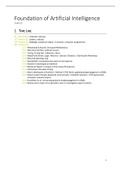College aantekeningen
Class notes of Foundations of Artificial Intelligence
- Vak
- 2AMU10 (2AMU10)
- Instelling
- Technische Universiteit Eindhoven (TUE)
This summary contains class notes made during the lecture, a summary of the provided slides, and images to elaborate on the subject.
[Meer zien]




